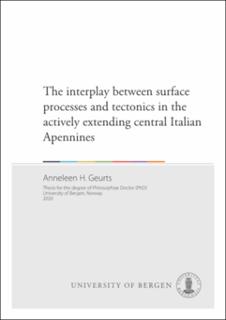| dc.contributor.author | Geurts, Anneleen H. | |
| dc.date.accessioned | 2020-05-22T05:53:14Z | |
| dc.date.available | 2020-05-22T05:53:14Z | |
| dc.date.issued | 2020-06-08 | |
| dc.date.submitted | 2020-05-19T00:14:30Z | |
| dc.identifier | container/5c/61/5b/87/5c615b87-881d-4d4c-8e73-dfec3e8ab939 | |
| dc.identifier.uri | https://hdl.handle.net/1956/22327 | |
| dc.description.abstract | The overall objective of this project is to improve our understanding of the interplay between surface processes and tectonics in active continental rifts, based on the central part of the Italian Apennines. Three key aspects are investigated: i) The impact of dynamic mantle-induced surface uplift on normal fault activity and topographic development in active continental rifts. ii) The evolution of drainage networks in response to extensional faulting and regional uplift and the main controlling mechanisms. iii) The impact of drainage network evolution on sediment dispersal, basin stratigraphy and transient landscape evolution. These three aspects are investigated through a combined field and numerical modelling approach. This approach allows for the direct use of field data for constraining numerical models, as well the direct testing of model-based findings. Synthesised published basin stratigraphic, fault slip and geomorphic data together with new geomorphic and sedimentological fieldwork provide high quality and detailed datasets of stratigraphic and landscape evolution in the central Apennines. Regional drainage network evolution in the central Apennines is primarily controlled by the balance between the rates of filling and subsidence of normal fault-bounded basins. Basin filling occurs through the supply of sediment and water, whereas basin subsidence is mainly controlled by slip on the main basin-bounding normal fault. Drainage integration occurs when initially underfilled, endorheic basins become overfilled with sediment and water allowing basins to overspill. Because basin overspill, in turn, allows water and sediment to cascade downstream to adjacent basins where it can trigger a next drainage integration event, drainage integration predominantly follows a top-down pattern. Furthermore, drainage integration acts as a first-order control on basin stratigraphy and geomorphic development in the central Apennines, and produces a highly dynamic landscape evolution with transient conditions that can persist in the landscape for several millions of years. Two-dimensional thermo-mechanical modelling results demonstrate how the removal of mantle lithosphere leads to regional surface uplift and the localisation of extensional strain in the area of high topography. This is because the upwelling of hot buoyant sub-lithospheric mantle within the lithospheric gap causes both isostatic surface uplift and considerable weakening of the crust. Pre-defined (inherited) fault structures in this area of uplift and weakened crust become activated if the area is subject to a low rate of far-field extension. Faults interact, causing the locus of fault activity to migrate across-strike, and fault slip rates to vary markedly over 104-105 year timescales. Overall, these experiments show that mantle lithosphere removal can explain many first-order characteristics of the central Apennines, such as the correlation between fault strain rates, topography and surface uplift, enhanced surface heat fluxes, negative gravity anomalies and low P-wave velocities in the upper mantle. | en_US |
| dc.language.iso | eng | eng |
| dc.publisher | The University of Bergen | en_US |
| dc.relation.haspart | Paper I: Geurts, A.H., Cowie, P.A., Duclaux, G., Gawthorpe, R.L., Huismans, R.S., Pedersen, V.K., Wedmore, L.N.J., 2018. Drainage integration and sediment dispersal in active continental rifts: A numerical modelling study of the central Italian Apennines. Basin Research, 30, 965-989. The manuscript is available in the main thesis. The published article is available at: <a href="https://doi.org/10.1111/bre.12289" target="blank">https://doi.org/10.1111/bre.12289</a> | en_US |
| dc.relation.haspart | Paper II: Geurts, A.H., Whittaker, A.C., Gawthorpe, R.L., Cowie, P.A., 2020. Transient landscape and stratigraphic responses to drainage integration in the actively extending central Italian Apennines. Geomorphology, 353, 107013. The manuscript is available in the main thesis. The published article is available at: <a href="https://doi.org/10.1016/j.geomorph.2019.107013" target="blank">https://doi.org/10.1016/j.geomorph.2019.107013</a> | en_US |
| dc.relation.haspart | Paper III: Geurts, A.H., Huismans, R.S., Cowie, P.A., Wolf, S.G., (in prep.) Dynamic normal fault behaviour and surface uplift in response to mantle lithosphere removal: A numerical modelling study motivated by the central Italian Apennines. Paper not available in BORA. | en_US |
| dc.rights | Attribution (CC BY) | eng |
| dc.rights.uri | https://creativecommons.org/licenses/by/4.0/ | eng |
| dc.title | The interplay between surface processes and tectonics in the actively extending central Italian Apennines | en_US |
| dc.type | Doctoral thesis | |
| dc.date.updated | 2020-05-19T00:14:30Z | |
| dc.rights.holder | Copyright the Author. | en_US |
| dc.contributor.orcid | https://orcid.org/0000-0002-2973-5946 | |
| fs.unitcode | 12-50-0 | |

